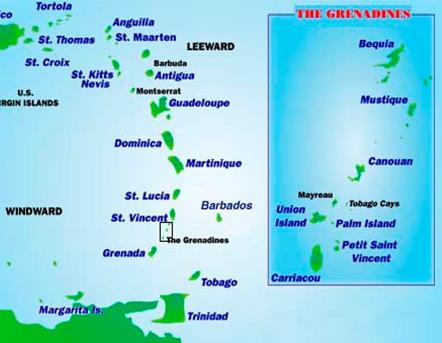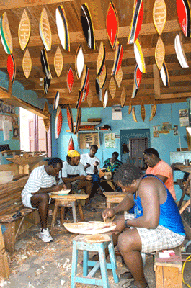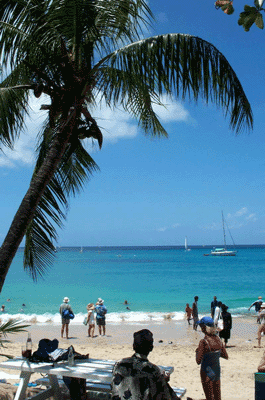
Environmental
 The tiny island of Bequia (or Bequai) is located in the Caribbean island chain that constitutes the country of St Vincent and the Grenadines, located off the northern coast of South America. At only 18 sq km. it is the largest of the 32 islands and cayes that make up the island state and is home to approximately 6,000 people.
The tiny island of Bequia (or Bequai) is located in the Caribbean island chain that constitutes the country of St Vincent and the Grenadines, located off the northern coast of South America. At only 18 sq km. it is the largest of the 32 islands and cayes that make up the island state and is home to approximately 6,000 people.
Beautiful sunny beaches, warm temperate climate and magnificent views of Bequia coastline are major assets in the Island of Bequia, highlighting the character of the island and its emphasis on developing sustainably such naturally occurring ecosystems in line with its dependence on tourism as a major revenue earner on the island. The islands array of beaches, bays and harbours offer up a diverse range of active and passive tourism experiences. The Princess Margaret beach is a beautiful, unspoilt beach and aptly named because Princess Margaret once swam there. Mount Pleasant typifies the diverse ecosystem of the island of Bequai this highland area of Bequai is a patchwork of tropical rainforest, densely wooded valleys and open moorland at the summit.

Economic
Tourism is the major driving economic force in Bequia and it is supported by the local fishing and arts and craft industry which comprises crafts as diverse as boat building to silk painting. Local currency is the Eastern Caribbean Dollar (EC$) which is pegged to the US dollar at approximately US $1 to EC $2.67.
Social
The people of Bequia are very open and friendly, along the shores of the harbour in Admiralty Bay, is the capital of Bequia called Port Elizabeth and this is the main location for shops of all types, restaurants, travel agents, banks, pharmacy, post office, Custom & Immigration, Police Station and Hospital. The Belmont Walkway, which runs from Port Elizabeth right along the southern side of the bay, gives tourists the opportunity to experience firsthand, lifestyles of the indigenous bequain people and opportunities to interact and mingle.
Institutional & Organizational
The island state of St Vincent & Grenadines gained independence from Britain in 1979 whilst remaining part of the British Commonwealth of Nations. The Governor General is the representative of the British Crown and is appointed by the Queen on the advice of the Prime Minister. The Constitution is based on the British Parliamentary System. There are 15 constituencies (Bequai & Mustique) together make up the constituency of the Northern Grenadines. The Legal System adopted in Bequia is based on British Common Law and is indicative of the islands British heritage.
The indigenes and authorities of Bequia place a high premium on keeping their environment clean as well as maintaining their beaches which attract tourists and is a high revenue earner for the island. Co-operation of various authorities and institutions on the island namely; Paget Farms, Bequia Tourism Association, Bequia District Council and Solid Waste Management Unit of Bequia in conjunction with schools, local businesses, community members and the local populace occurs frequently to ensure that the beaches and facilities are in pristine condition.
Cultural

Bequia earliest inhabitants dating back to the beginning of the first millennium AD were small groups of pottery making Amerindians with origins lying in the northern coastal regions of South America. These early indigenous people were followed in around 1400 AD by another group called the Island Caribs who together with their fellow Caribs in St Vincent and Dominica successfully resisted the onslaught of European colonization in the 16th and 17th centuries. In the late 16th century, indigenous yellow Carib had to a great extent merged with shipwrecked or runaway African slaves to give rise to the Black Caribs. The black Caribs formed an alliance with the French and permitted them to develop small settlements. Bequia at this point was considered to be part of French owned Grenada and very much under French control. The turning point in Bequia's colonial history came with the cessation of hostilities between the British and the French in the seven years war marked in 1763 by the Treaty of Paris. By this treaty both the previously neutral St Vincent and the French controlled Grenadine Islands were ceded to the British. Bequia is a culturally diverse island and typifies the term a “melting pot of cultures”. There is an intriguing mix of native bequains of African, Scottish, Irish, French, Indian and Carib descent many of whom can trace their ancestry directly back to the islands earliest inhabitants of the 18th century and the more recent settlers of Europe who have made Bequia their home thus further enriching the broad cultural diversity of Bequia even further.
April 2010 © C-Change Secretariat (Canada) & C-Change Partners for Bequia.
Community Links
FAO Fisheries Profile - Bequia




























